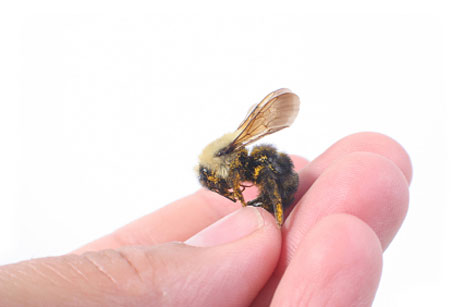 Remember the case of the leaked document showing that the EPA’s own scientists are concerned about a pesticide it approved that might harm fragile honeybee populations?
Remember the case of the leaked document showing that the EPA’s own scientists are concerned about a pesticide it approved that might harm fragile honeybee populations?
Well, it turns that the EPA isn’t the only government agency whose researchers are worried about neonicotinoid pesticides. USDA researchers also have good evidence that these nicotine-derived chemicals, marketed by German agrichemical giant Bayer, could be playing a part in Colony Collapse Disorder — the mysterious massive honeybee die-offs that United States and Europe have been experiencing in recent years. So why on earth are they still in use on million of acres of American farmland?
Independent film blockbuster
According to a report by Mike McCarthy, environment editor of the U.K.-based Independent, the lead researcher at the USDA’s very own Bee Research Laboratory completed research two years ago suggesting that even extremely low levels of exposure to neonicotinoids makes bees more vulnerable to harm from common pathogens.
For reasons not specified in the Independent article, the USDA’s Jeffrey Pettis has so far not published his research. “[It] was completed almost two years ago but it has been too long in getting out,” he told the newspaper. “I have submitted my manuscript to a new journal but cannot give a publication date or share more of this with you at this time.” (I was not able to speak to Pettis for this post as he is in meetings all day today; but he’s agreed to an interview Monday.)
Pettis’s study focused on imidacloprid, which like clothianidin is a neonicotinoid pesticide marketed by Bayer as a seed treatment. The findings are pretty damning for these nicotine-derived pesticides, according to McCarthy. He summarizes the study like this:
The American study … has demonstrated that the insects’ vulnerability to infection is increased by the presence of imidacloprid, even at the most microscopic doses. Dr. Pettis and his team found that increased disease infection happened even when the levels of the insecticide were so tiny that they could not subsequently be detected in the bees, although the researchers knew that they had been dosed with it.
To my knowledge, Pettis hasn’t spoken to U.S. journalists about his unpublished neonicotinoid research. But he did appear in a 2010 documentary called The Strange Disappearance of the Honeybees by U.S. filmmaker Mike Daniels, which has been screened widely in Europe but not yet in the United States, McCarthy reports. Pettis’ remarks in the film are what alerted the European press to his findings on neonicotinoids.
I have not been able to view the film, but I have obtained a copy of the transcript [PDF] of the portion in which Pettis appears. The filmmaker caught up with Pettis at an international conference of bee scientists known as Apimondia in Montpellier, France, in September 2009. Apparently attendees had been buzzing (sorry) about research by Pettis showing that low levels of neonicotinoid pesticide interacted with common pathogens in a damaging way for bees. Pettis and his research collaborator, Penn State University entomologist Dennis Van Engelsdorp, spoke frankly about their findings for the film.
In the transcript, Pettis says he and his research team exposed two sets of honey bees to Nosema, a fungal pathogen toxic to honey bees. One set was also exposed to a neonicotinoid pesticide; the other not. “And we saw an increase, even if we fed the pesticide at very low levels — an increase in Nosema levels — in direct response to the low level feeding of neonicotinoids, as compared with the ones which were fed normal protein,” Pettis says in the film, according to the transcript.
Van Engelsdorp stressed that the changes occurred even at levels of neonicotinoid exposure “below the limit of detection.” He adds:”The only reason we knew the bees had exposure [to neonicotinoid pesticides] is because we exposed them.”
Neonicotinoid patch
This is potentially game-changing research for understanding Colony Collapse Disorder. Scientists have been focusing on the interaction between the Nosema fungus and a virus called Iridoviridae as the culprit. Pettis’ research seems to suggest that neonicotinoids play a role, too — and at levels so low that researchers may be overlooking them.
So, let’s get this straight. The chief scientist at the top U.S. government bee-science institute completed research two years ago implicating a widely used, EPA-approved pesticide in what can plausibly be called an ecological catastrophe — the possible extinction of honeybees, which pollinate a huge portion of U.S. crops. Why are we just now hearing about this — and why are we only hearing about it through an obscure documentary filtered through a British newspaper?
I’ll be digging into these questions next week.
In the meantime, consider this. As I wrote in my December piece on this topic, Bayer’s neonicotinoid pesticides are taken up by millions of acres of corn plants every year and expressed in pollen fed on by countless honeybees. It’s time for the EPA and USDA to be absolutely open about their scientists’ concerns about these poisons — open about it, and willing to act on it.



